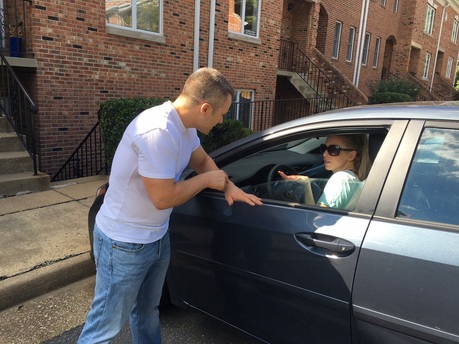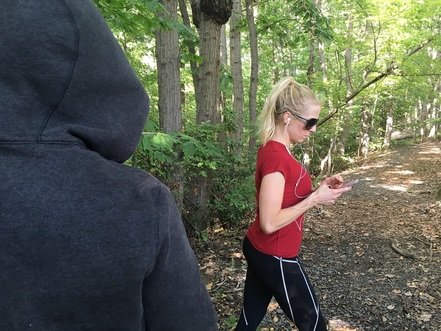The other day when she was on her way back to her apartment he said, “Ah, coming back from class?”
So she asked, what can I do about this guy? He gives her a creepy vibe but has never said anything vulgar, crossed any physical boundaries, threatened or attacked her, so it becomes a bit tricky, because until and unless he does something requiring an assertive response, she’s in a situation where she has a proximity issue with a man who has a right to there, since he lives in the same complex.
I explained to her that this can be somewhat different than the normal scope of the 3E’s of being Elusive: Empathy Excuse Exit, which I taught her for dealing with strangers approaching, though it can be modified to fit the situation. Quick re-cap of 3E's:
Empathy hands addressing the person, “Sorry man…
Excuse: “…I can’t”
Exit keep moving if you have mobility
The difference is that he is someone who does not believe he is a stranger to you because you have something in common, therefore his attempts and questions could be different from the norm and drawn out over time, particularly if he is asking about personal information.
Action points: Avoidance and variation of your movement patterns would be preferred. Does the building have multiple entrances and exits where security cameras, other tenants, or a concierge will be present?
If contact is inevitable any conversation with this person should be engage-to-disengage with the intent of projecting that you are not an interesting person to talk to, you do not engage in small talk, and you don’t divulge personal information.
*Please note- I am not advocating to be unfriendly to your neighbors, having good neighbors that you communicate with is a great thing and can be beneficial for the safety of the whole community; however, this scenario is different in that she feels particularly uncomfortable about this individual
Back to her example, “Ah, coming back from class?" Though he can deduce patterns from when he sees you, do NOT say anything that would divulge information about your occupation or schedule. He does not need to know when you will be home, away, or what floor and room you live in (if he does not already know).
We role-played an example response to this where she got to be the creepy man, and I role-played as her:
Her: “Ah, coming back from class?”
Me: “Nah same old shit,” spoken in a disgruntled manner with a disinterested look on my face, as put one hand up like a half-shrug as I walked by her.
Her: “Whoa, okay.”
It was odd to her what I said and how I said it. In this example, what I set forth with my word-choice, tone, and body language that I am not big on small-talk and not interested in talking (concerns me how natural that was for me). My response also was not a yes or no to the fishing-for-information question.
What you say and how you say it are important. How you speak to this person should be something that flows naturally with your language pattern so that it is interpreted as authentic. If you have trouble with this, practice it with a friend.
The feedback and response you get after this type of encounter can illuminate whether this person picks up on social cues and personal space, this is important since you will likely see him again.
If seemly creepy guy downgrades from an attempted conversation or fishing for information to an awkward “Hi” or a hand-wave, that’s great, we’re moving in the right direction! If he continues pressing for information, you have still learned information about this person, maybe that he does not pick up on social cues or does not care. You still might have to address things more directly or more assertively to make sure it is clear that you are not interested in talking to him. Regardless, priority would be avoidance, not divulging information, and not hanging around for small talk with the person you do not want to talk to.
Train smart, stay safe, and manage the weird, socially-awkward gray-areas with confidence,
Evan D.
Owner/Lead Coach
NOVA Self Defense
We strongly advocate learning in a hands-on environment where you can get exposure to improve your awareness, mindset, and confidence in handling situations that occur in the real-world. Not every situation is an outright physical assault, so in addition to having the physical skills to defend yourself, having the skills and confidence to manage the social situations can go a long way to improve your confidence and quality of life. If you are near the DC or Northern Virginia area, come train with us!
Sign up for one of our introductory self defense courses here
For corporate self-defense training or customized violence prevention training email [email protected]















 RSS Feed
RSS Feed